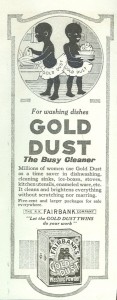The ever-fantastic Sarah Haskins on car ads aimed at women:
For other examples of marketing cars to women, see here, here, here, here, here, and here.
Vintage Ads posted these three ads–one for an electric refrigerator and two for Gold Dust Cleaner–that compare the product to a Black servant.
The copy in the refrigerator ad reads: “And So Electricity Is Made The Willing Servant.” The accompanying image includes three white women looking leisurely and a Black servant.
Similarly, these two Gold Dust ads personify the product as Black twin babies. The motto is: “Let the GOLD DUST TWINS do your work.”


I think these are fascinating in that they draw our attention to whose work technology is designed to replace. Earlier on this blog we’ve talked about how ads have offered to replace women’s work with the market and with technology. In these cases, the market and technology were needed to ease women’s workload (they certainly couldn’t expect their husbands to do it). In this case, Black servants serve to take women one step further from “women’s work.” Instead of replacing women themselves, the product replace the servants who replaced women, making the comparison of the product to Black servants completely sensical at the time.
Telefono Donna, a rape crisis hotline in Italy, designed a poster to raise awareness of rape in honor of November 25, the International Day to for the Elimination of Violence Against Women. Some conservative politicians in Milan object to the Christ-like pose taken by the bare-breasted model in the poster. From the UK Telegraph:
“We’re calling for the poster to be withdrawn because an important day like this should not be debased by such a sexual provocation,” said councillor Carlo Fidanza, a member of the right-wing National Alliance party.
But the president of the Telefono Donna rape helpline, Stefania Bartochetti, said she was surprised by the controversy because the poster had raised no objections in other Italian cities.
“As a Catholic I can’t see anything offensive or blasphemous. We chose a strong image to encourage more rape victims to break their silence,” she said.
The poster poses the question: ‘Who Pays For Man’s Sins?’ and a caption which reads “Only four per cent of women who suffer sexual violence report their assailants.”
Left-leaning politicians said their opponents’ concerns were out of step with contemporary Italian society.
“If you applied these standards to Italian television, you’d have to get rid of 70 per cent of what the main channels broadcast,” said Pierfrancesco Majorino, of the Democratic Party.
Small reproduction of the poster, showing bare-breasted woman [NSFW], below the cut. more...
Breck C. sent us this link to a collection of photographs of Harajuku Girls. Harajuku is a style for teenagers in a region of Japan (here is the wikipedia entry). I can’t think of a way to describe them that does them justice, so here are some pictures (found here, here, here and here):
In 2004, Gwen Stefani began touring with four women posing as Japanese Harajuku girls. Stefani’s Harajuku Girls serve as her entourage and back-up dancers. Here she is with four (Japanese?) women that she hires to be her Harajuku Girls (found here and here):
In the comments, Inky points out that Stefani says this about them in her song, Rich Girl:
I’d get me four Harajuku girls to
Inspire me and they’d come to my rescue
I’d dress them wicked, I’d give them names
Love, Angel, Music, Baby
Hurry up and come and save me
Stefani also has a Harajuku Lovers clothing line and a series of perfumes, one for her, and one for each Harajuku Girl:
I think that Stefani’s use of Asian women as props (they may or may not be Japanese) fetishizes Asian women and reinforces white privilege. The Harajuku Girls serve as contrast to Stefani’s performance of ideal white femininity. It makes me think of both this poster on colonial-era travel and this fashion spread.
Yet, Stefani’s been at this for four years and I can’t remember hearing any objections to her Harajuku Girls, even in feminist and anti-racist alternative media. Further, if her fashion line, perfume, and continued employment of the Harajuku Girls are any indication, people seem to think the whole thing is awesome. In the meantime, I bet she’s making bank on her clothing line and perfume. Where’s that money going?
Do you think my reading is fair?
And, if so, why do you think there’s been so little outcry?
For good measure, here she is performing with her “Girls”:
In our comments, SG asks that we include the following clarification:
This article is really misrepresenting a whole fashion scene and I would like to ask that you correct it- It is just perpetuating the idiocy and ignorance surrounding these styles. “Harajuku is a style for teenagers in a region of Japan”. “Harajuku style” Is a term coined by western media because they are too ignorant to actually research the names of these actual styles. Harajuku is not a style. It is a location. The females you have pictured are in Decora (and two in Visual Kei). The only “harajuku style” that exists is the fictional one made up by Gwen Stefani and the western media.
Thanks SG.
See also our post featuring other examples of ads and artists using Asians as props.
Elizabeth recently posted about an ad for Motrin that suggested that you should take pain medicine so as to keep walking in pain-inducing high heels. The message was, essentially, “Suffer for fashion, ladies! Motrin will help!” I wanted to discuss, also, this second ad in their series (found here) and an anonymous commenter egged me on:
[youtube]https://www.youtube.com/watch?v=XO6SlTUBA38[/youtube]
They start off saying that how mothers make decisions about how to carry their infants according to what is in style (“Wearing your baby seems to be in fashion”). They then point out that what is currently in fashion is painful for mothers. But, of course, moms are going to do it anyway, because the sacrifice is for the child (“It’s a good kind of pain, it’s for my kid”). But also about fashion! And about how in-fashion it is to be a mom! (“Plus it totally makes me look like an official mom”).
The ad trivializes motherhood (threatening to reduce it to fashion), equating it, in a sense, to the high heels in the other ad. At the same time, it legitimizes suffering in the service of your child, which reinforces the ideology of intensive mothering that has ramped up the must-haves and must-dos of mothering like never before in human history.
The good news is that Motrin pulled this ad campaign and has apologized after bloggers took them to task.
Lisa Wade, PhD is an Associate Professor at Tulane University. She is the author of American Hookup, a book about college sexual culture; a textbook about gender; and a forthcoming introductory text: Terrible Magnificent Sociology. You can follow her on Twitter and Instagram.
These ads, for a “fashion brand for teenagers” (according to Adverbox), use the trope of colonial taxidermic collection, to promise death to the tween love of Hello Kitty, Snoopie, Minnie and Mickey Mouse, teddy bears, unicorns, Bugs Bunny, Pinnochio, and more.
As a kid who hated Hello Kitty more than life itself and as an adult who just doesn’t get a life-long love of Disney, these ads appeal to me. As a sociologist, their colonial trappings disturb me. I’d love to hear your thoughts.
Cross posted at Racialicious.
In many places in the midwest the American Indian is very present, but in other places in the U.S., like in California, Disney’s Pocahontas is as close as we get to “Indians.” The idea that American Indians are gone comes, in part, from the ubiquitous representation of them with feathers, buckskins, and moccasins. These anachronisms are everywhere (see, for example, here, here, here, here, and here).
American Indians are as modern as the rest of us, why are representations of American Indians, as they live today, so unusual? And what effect might that have on the psyche of American Indian people?
Via PostSecret.
NEW! One of the commenters at Racialicious pointed us to a cartoon that illustrates how anachronistic images of American Indians may shape our ideas of what they are like:
One of the magazines for the obscenely rich that I’ve been perusing lately was Yachts International magazine.
In it was a glaring Sociological Images story. Paging through the magazine it became exceedingly clear that yachts were one prize for extreme economic success… and women were another. Below I have uploaded every ad in the magazine that included people. Across all of the ads, there are 22 women and four men. The women are, overwhemingly, posed as beautiful objects that adorn beautiful yachts.
Each of the ads is embedded after the jump (there’s a lot and they take some time to load):